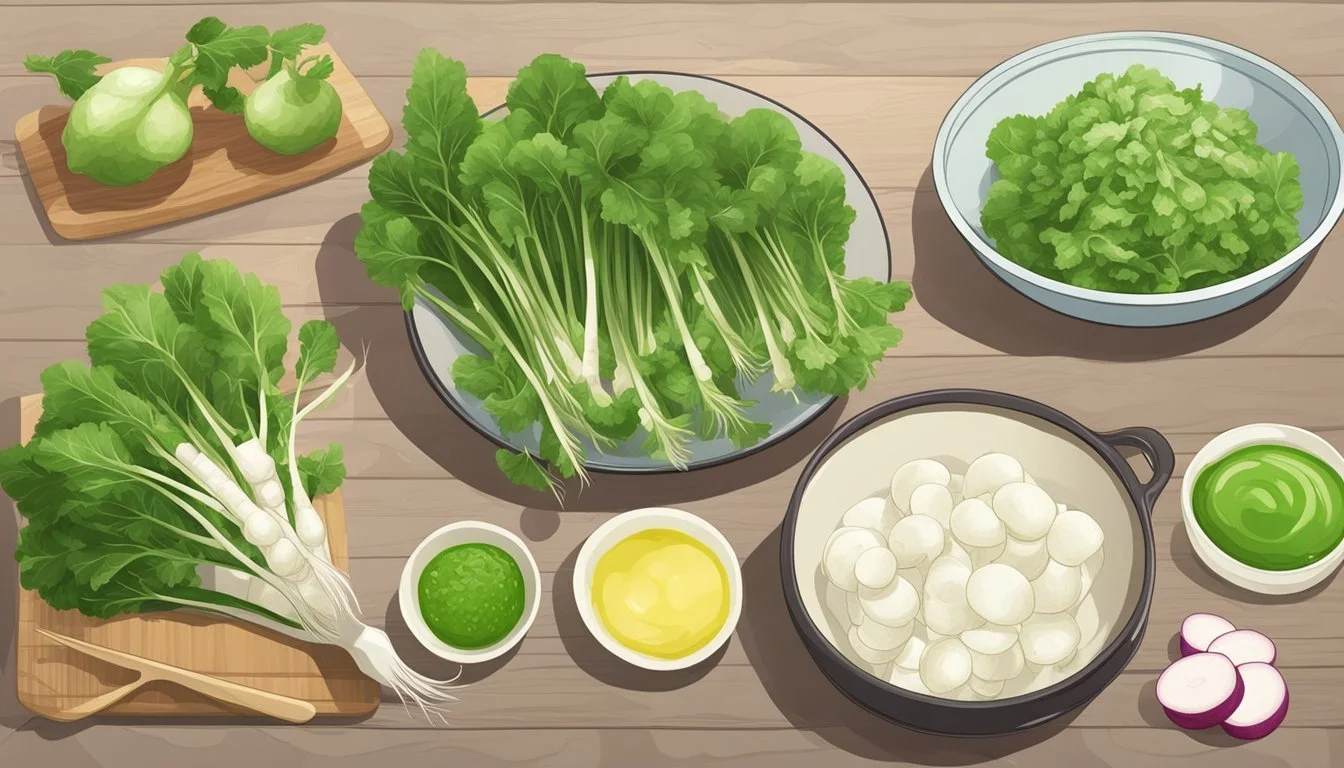Green Meat Radish Substitutes
Top Alternatives for Your Recipes
Green meat radishes, known for their spicy flavor and crisp texture, can elevate a variety of dishes from salads to tacos. Sometimes, though, finding them might be challenging. Several substitutes can effectively replace green meat radishes while maintaining the desired flavor and crunch in your recipes.
Horseradish root, with its similar spicy kick, is an excellent substitute. It can be used in fresh preparations, such as salads or as a condiment. Another viable option is jicama, which offers a sweet, nutty flavor and pairs well with greens in raw dishes, providing a satisfying crunch.
Kohlrabi, with its slightly sweeter taste, can also serve as a substitute for green meat radishes. Its firm texture makes it perfect for salads and slaws. Whether you're looking for a similar flavor or texture, these alternatives ensure that your dishes remain delicious and diverse.
Understanding Green Meat Radish
The Green Meat radish, a variety of daikon radish, is known for its unique properties. It has a cylindrical shape and its vibrant lime green flesh stands out. The exterior is typically green near the stalk and fades to cream-colored tips.
Texture: This radish offers a crisp texture, which adds a refreshing crunch to dishes.
Flavor: The flavor profile is predominantly mild with a peppery kick. This makes it versatile in both raw and cooked preparations.
Nutritional Benefits
Green Meat radishes are rich in several nutrients, including:
Vitamin C: Important for immune function and skin health.
Folate: Essential for DNA synthesis and repair.
Fiber: Aids in digestion and promotes overall gut health.
Antioxidant Properties: Helps in reducing oxidative stress.
Culinary Uses
This radish shines in fresh preparations. It can be thinly sliced for sandwiches, salads, or wraps. Additionally, it pairs well with cream-based dips and soft cheeses.
Serving Suggestions:
Salads: Adds crunch and a peppery flavor.
Condiments: Grated and served with sushi or sashimi.
Tacos and nachos: Adds a spicy accent.
Green Meat radishes are a versatile ingredient that elevates many dishes with their distinctive flavor and texture.
Reasons to Substitute Green Meat Radish
Substituting Green Meat radish might become necessary due to unavailability in stores, varying taste preferences, desired textural qualities, or specific dietary needs like allergies or health concerns.
Availability Issues
Green Meat radish, a specialty produce, can sometimes be hard to find in local stores. Limited availability might be due to seasonal growing conditions, regional limitations, or low demand. When it isn't readily available, finding suitable substitutes such as jicama, kohlrabi, or horseradish can avoid disruptions in your meal plans. These alternatives are commonly found and can offer similar textures and flavors.
Flavor Preferences
The spicy flavor of Green Meat radish may not cater to everyone's taste. For those who prefer a milder flavor, substitutes like parsnips or watermelon radish provide a sweeter and less pungent taste. On the other hand, horseradish can cater to those seeking an equally bold, if not spicier, punch. Adjusting the flavor profile allows customization to individual palates and recipes.
Textural Considerations
The crisp texture of Green Meat radish is one of its defining features. However, some dishes might demand variations in texture. Jicama, with its similar crunch, or kohlrabi, offering a slightly softer bite, can effectively replace Green Meat radish. These substitutes ensure the dish maintains the desired crunch or softness without compromising on quality.
Dietary Restrictions
Dietary restrictions, including allergies or specific health concerns, can necessitate a substitute for Green Meat radish. Some individuals might be allergic to specific radishes or need to avoid them due to digestive issues. Alternatives such as mild-flavored parsnips or nutrient-rich jicama can provide the necessary dietary flexibility while maintaining the nutritional benefits and culinary appeal of the original ingredient.
Popular Substitutes for Green Meat Radish
Green meat radish can be substituted with various vegetables that share similar textures and flavors. Common alternatives include daikon radish, watermelon radish, turnips, red radish, and jicama. Each substitute offers distinct tastes and textures that can enhance the dish in unique ways.
Daikon Radish
Daikon radish is a popular substitute due to its mild flavor and crisp texture. It is slightly sweet and less peppery compared to green meat radish, making it suitable for those who prefer a subtler taste.
Daikon can be sliced thin and used in salads, sandwiches, or wraps, where its crunchiness adds a refreshing element. It also pairs well with cream-based dips or soy sauce, enhancing appetizers and side dishes.
Watermelon Radish
Watermelon radish stands out with its vibrant pink interior and mild flavor. It provides a crisp texture similar to green meat radish and can be used in both raw and cooked forms.
This radish is especially appealing in salads due to its eye-catching color, which can elevate the visual appeal of a dish. Its mild pepperiness complements various greens and other vegetables.
Turnips
Turnips offer an earthy flavor with a hint of sweetness, making them a good alternative. While their texture may be slightly less crunchy, they still hold up well in raw and cooked dishes.
Turnips can be sliced or grated to add a crunchy element to salads or slaws. They can also be roasted or sautéed to enhance their natural sweetness, providing a versatile substitute in numerous recipes.
Red Radish
Red radish is a close substitute, offering a similar peppery flavor and crisp texture. It is smaller and more colorful, which can add a visual and flavorful punch to dishes.
These radishes can be used in salads, tacos, and sandwiches, where their sharp taste provides a contrasting element. Sliced thin, they work well as garnishes or in combination with other vegetables.
Jicama
Jicama provides a sweet, nutty flavor and a firm, crunchy texture. Although it is not spicy, its crispness makes it a suitable replacement in dishes where texture is important.
Jicama shines in salads, where its natural sweetness can balance more intense flavors. It can be julienned or diced to match the size and shape of green meat radish slices, ensuring a pleasing crunch in every bite.
Vegetable Alternatives by Texture and Flavor
Vegetables can offer a variety of textures and flavors similar to green meat radishes, making them versatile substitutes in various recipes.
Crunchy and Peppery
Celery and fennel are excellent options for a crunchy and peppery alternative. Celery provides a firm texture and a slightly bitter, peppery flavor that works well in salads and as a snack with dips. Fennel, with its crunchy texture and mild anise flavor, brings both a peppery and slightly sweet taste.
Example Uses:
Add to salads for a peppery bite.
Incorporate into soups for texture and flavor.
Use in dips for a crunchy snack.
Crunchy and Sweet
Jicama and carrots are notable vegetables with a crunchy and sweet profile. Jicama offers a crisp texture and a sweet, nutty flavor, which pairs well with both fresh and cooked dishes. Carrots, with their familiar crunch and mildly sweet taste, can replace radishes in salads, slaws, and even roasted dishes.
Example Uses:
Slice jicama or carrots into sticks for a fresh, sweet snack.
Grate into salads or slaws for an added crunch.
Roast with a drizzle of olive oil and herbs.
Softer and Earthy
For a softer and earthier substitute, beets and parsnips are ideal. Beets have a tender texture when cooked, with a sweet and subtly earthy taste. They can add color and depth to various dishes. Parsnips offer a similar appearance to pale carrots, with a soft texture after cooking and an earthy, sweet flavor that complements many recipes.
Example Uses:
Roast beets or parsnips for a tender, earthy side dish.
Incorporate cooked beets into salads for an added soft texture.
Mash parsnips for a sweet and earthy alternative to potatoes.
Herbs and Roots as Flavor Substitutes
This section will explore how different herbs and roots can enhance your culinary creations by substituting for green meat radish. Each alternative brings its own unique flavor and texture to your dishes.
Horseradish for a Spicy Kick
Horseradish root offers a robust spicy flavor profile. Known for its pungent taste, horseradish can be used sparingly to impart a similar heat to that of green meat radish. The root is often grated and mixed with salt and vinegar to create a potent condiment.
When substituting, keep in mind that horseradish is significantly stronger. Start with a smaller amount and adjust according to taste. This makes horseradish ideal for sauces and marinades where a spicy element is desired.
Horseradish is also beneficial thanks to its tangy notes, which can enhance a variety of dishes, from salads to grilled meats. Always use fresh horseradish for the best flavor impact.
Celery Root for a Milder Taste
Celery root, or celeriac, provides a milder alternative to green meat radish. It has a nutty and slightly sweet flavor that complements many recipes. This root can be grated, sliced, or even cooked, depending on the dish’s requirements.
Unlike the intense spice of horseradish, celery root offers a subtle enhancement. It can be used raw in salads or cooked in soups and stews for a more nuanced taste.
Celery root is also a good source of fiber and adds a pleasant texture. For those who prefer a less spicy substitute, celery root is an excellent choice.
Fennel for a Sweet Note
Fennel brings a sweet note to dishes, making it a versatile substitute for green meat radish. The bulb of the fennel plant has a sweet and slightly anise-like flavor, which can be used raw or cooked without overwhelming other flavors.
When using fennel as a substitute, slice it thinly for salads or roast it to bring out its natural sweetness. Fennel pairs well with both savory and sweet ingredients, adding complexity to your dishes.
This root is particularly useful in recipes where a sweet flavor is required, without the spicy kick of radish. Fennel is also rich in vitamins and offers great nutritional benefits. For a unique twist, consider adding fennel to your culinary repertoire.
Incorporating Substitutes in Various Dishes
There are various ways to use substitutes for green meat radish in dishes such as salads, cooked preparations, pickled items, and as raw snacks. Using substitutions effectively can enhance the flavor and texture of your meals.
Salads and Slaws
Substituting green meat radish in salads and slaws can be done with options like kohlrabi and jicama. Kohlrabi provides a slightly sweeter taste while maintaining the crunchy texture that's essential in salads. Jicama adds a sweet, nutty flavor and a satisfying crunch, making it great in mixed greens and vegetable slaws. Beets are another alternative, offering a vibrant color and earthy taste that complements various dressings.
Roasted and Cooked Applications
For cooked recipes, substitutes like parsnips and beets work well. Parsnips, with their subtle sweetness, can be roasted to bring out their flavor, making them a good stand-in for green meat radish. Beets, on the other hand, add a deep, rich flavor when roasted, fitting well in dishes like tacos and wraps. Kohlrabi can also be roasted or sautéed, providing a tender texture and mild taste.
Pickled Preparations
In pickling, substitutes such as watermelon radish and horseradish root can be used. Watermelon radish, with its mild, sweet, and slightly spicy flavor, offers a visual and taste appeal to pickled items. Horseradish root, when mixed with salt and vinegar, provides the spicy kick typical in pickled radish preparations. These alternatives can be used in sandwiches and tacos to add a tangy, crisp bite.
Raw Snacks and Garnishes
When enjoyed raw, jicama and watermelon radish are excellent choices. Jicama's sweet, crunchy texture makes it a perfect snack or addition to vegetable platters. Watermelon radish, with its striking appearance and mild spice, serves as an attractive and tasty garnish for various dishes like salads and wraps. Beets, thinly sliced, can also add color and crunch to raw snacks and garnishes.
By effectively incorporating these substitutes, a variety of flavors and textures can be achieved, enriching your recipes without losing the desired characteristics of green meat radish.
Non-Vegetable Alternatives
For those seeking non-vegetable substitutes for green meat radish, several options can be considered to achieve a similar texture and flavor profile in recipes.
Butter adds a creamy texture and rich flavor to dishes that need a substitute for radish. It can be particularly effective in soups, sauces, and sautéed dishes. Adding butter helps to provide a smooth and velvety mouthfeel.
Fruit, such as green apples or pears, can provide a sweet and tangy alternative to radish. Their crisp texture and refreshing taste make them suitable for salads and snacks. Slice them thinly to maintain the desired crunch in your dishes.
Pork offers a meaty and umami flavor that can replace radish in some savory dishes. Thinly sliced pork can be used in stir-fries or grilled to add a hearty element. Its versatility allows it to blend well with various seasonings and sauces.
Comparison Table:
Substitute Texture Flavor Best Used In Butter Creamy, Smooth Rich, Buttery Soups, Sauces, Sautéed dishes Fruit Crisp, Refreshing Sweet, Tangy Salads, Snacks Pork Tender, Meaty Umami Stir-fries, Grilled dishes
Different dishes may require different substitutes, but these non-vegetable alternatives provide versatile options for those who want to replicate the qualities of green meat radish.
Health Considerations When Choosing Substitutes
When choosing green meat radish substitutes, it's important to consider various health factors. These substitutes can impact diet and overall well-being in different ways.
Green meat radish substitutes often offer high fiber content, which aids in digestion and helps maintain a healthy gut. Fiber-rich foods can prevent constipation and promote regular bowel movements.
These substitutes may also be rich in Vitamin C, an essential nutrient that supports the immune system and promotes healthy skin. Including Vitamin C in your diet can help protect against common illnesses.
Many substitutes contain essential minerals such as potassium, magnesium, and calcium. These minerals are vital for maintaining bone health, nerve function, and muscle function.
Antioxidant properties are another consideration. Radish substitutes often have antioxidants that help reduce oxidative stress in the body, potentially lowering the risk of chronic diseases.
When evaluating these substitutes, it's useful to compare their nutritional profiles. The table below can help summarize key nutrients:
Nutrient Importance Found in Substitutes Fiber Aids digestion Common Vitamin C Boosts immune system Common Potassium Supports heart and muscle function Variable Magnesium Regulates muscle and nerve function Variable Antioxidants Reduces oxidative stress Common
Considering these health factors ensures that you choose substitutes that benefit your diet and support overall wellness.
Storing Substitutes for Freshness and Longevity
To maintain the freshness and longevity of substitutes for green meat radish, proper storage techniques are essential.
Refrigeration is key for most substitutes. For example, jicama should be stored in the crisper drawer to prevent it from becoming too moist.
Cellophane-wrapped carrots should be stored in the fridge to preserve their crunch.
For vegetables like turnips and green apples, storing them in a cool, dry place is effective. Place them in a breathable container to avoid moisture buildup.
Here are some tips:
Horseradish: Keep in a tightly sealed container in the fridge.
Watermelon Radish: Can be stored wrapped loosely in a plastic bag in the crisper drawer.
Daikon: Remove the greens and store the root in the refrigerator, wrapped in a damp cloth.
Freezing is another good technique for longer preservation. Vegetables like carrots and daikon can be blanched and then frozen to extend their shelf life.
Pickling can also preserve substitutes like turnips and carrots, keeping them fresh for weeks.
Using these storage methods will help ensure substitutes for green meat radishes remain fresh and ready for use.
Understanding Radish Varieties
Radishes come in an impressive array of shapes, colors, and flavors. Each variety offers unique attributes, making certain types more suitable for specific culinary applications.
Types of Radishes
Radishes are generally categorized into spring, summer, and winter types. Spring radishes are quick to mature and have a crisp texture. Summer radishes are larger, while winter varieties, such as daikon, often have robust flavor profiles and storage capabilities. Popular types include French Breakfast, Cherry, Korean, and Black radishes.
French Breakfast Radish
French Breakfast radishes feature a distinctive elongated, cylindrical shape with white tips. Known for their mild flavor, they are ideal for salads or as garnishes. These radishes mature quickly and can be consumed raw or lightly cooked. Their vibrant appearance and delicate taste make them a favorite in springtime dishes.
Cherry Radish
Cherry radishes are round, red, and slightly pungent. They offer a crisp texture and peppery flavor, making them suitable for fresh consumption. These radishes are often sliced and added to salads or used as a crunchy topping for various dishes. They are a versatile addition due to their bright color and refreshing taste.
Korean Radish
Korean radishes, or mu, are larger and have a denser flesh compared to other varieties. These radishes are typically used in Korean cuisine for making kimchi or soups. They are less spicy and have a slightly sweet flavor. Their firm texture holds up well in cooking, offering a satisfying crunch.
Black Radish
Black radishes are easily recognized by their dark, rough skin and white interior. They have a more intense, peppery flavor than other radishes. These radishes can be roasted, boiled, or used raw in salads. Their robust taste pairs well with rich, hearty dishes, providing a striking contrast.
Each radish variety brings something unique to the table, allowing for diverse culinary possibilities.









